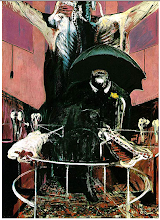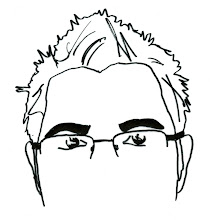Over the past 6 months, many guest lecturers have attended Stockport College. From individuals who have set up on their own, to representatives of successful agencies up and down the country. These agencies included, ‘Fudge’ , ‘Thoughtful’ , ‘Glorious’ and ‘Truth’ to name but a few. A couple of the freelancers particularly stood out and although their styles were completely different, the media they were using was almost the same. ie: moving image.
Grant Gilbert set up Double G. Studios. He is London based and studied at Stockport College and then continued his education at Birmingham University. After completing his degree he managed to land a job on a Channel 4 show called ‘The Big Breakfast’. This was the break he needed and he started to learn his trade, applying his knowledge to national television. From here he worked on other popular shows including ‘The Word’, doing promos and title sequences. This was all good experience and a kind of learning on the job. With this under his belt he jetted off to New York to an agency called ‘The Attic’. Eight years ago he returned to England to work for himself.
Tal Rosner on the other hand is a self-taught film maker and graphic designer. Incorporating his two skills to create short moving pieces, that are sometimes commissioned and sometimes not, for a variety of events. These have also included title sequences for Channel 4, including a very successful show called ‘Skins’.
The similarity between the two isn’t so far away as may first seem. Rosner on one hand may have a blank canvas and get to make the images/film himself, almost as if it is an entire package, but Gilbert, apart from not actually putting the moving image together, still has to produce an aesthetically pleasing combination of graphics relating to what the viewer is going to watch. A trailer is no good unless one knows what one is watching. Hence both designers are essentially serving the same purpose of the client. Almost.
Whereas Gilbert will specifically design a new logo and graphics for a piece that has been handed him, normally involving a tight brief/rigid guidelines that he must adhere to, Rosner tends to get more flexible ones. His idea will be pitched to the client after he has explained it to them previously, and obviously tailored to their needs. Gilbert on the other hand will be given film and has to fit the graphics/logo with this. This then becomes subjective when shown to the client and may well be changed several times before an agreeable outcome has been reached.
Although Rosner could be almost seen as a fine artist with his work being likened to that of someone with their own idea and placing it into a gallery as some sort of installation, Grant Gilbert will have his brief given him and from there his creativity will be applied to it.
Rosner will also have these but combines his time with his own personal projects which he will pitch to clients. Sometimes the client will not know they needed a change/design, as he seems to like to do everything for himself and then sell it, convincing someone they want his work. This work is diverse and his reputation is that good, most people will source him out.
To an extent this is also true of Gilbert, as having successfully completed logos for Channel 5, BBC1, Smirnoff, More 4 and C4.Com, his excellence speaks for itself. Most people will know what a high standard he is capable of. This though is no guarantee of clinching a new contract as he still has to compete with other agencies, spending time and effort into a project that there is no certainty he will get.
The process used by both are once again similar, as the majority sit over moving image. But Gilbert trained as a graphic designer and then moved his career towards television and film. This was a necessity for him as this is where a lot of the industry is headed. The tendency in the current ‘green climate’ is if something is put on paper this is wasteful of our natural resources, whereas something on a screen can be used over and over. Most people these days will look to a computer for information thus the same design can be seen by millions of people. If it was to be printed the costs would be astronomical, not only monetary but environmentally.
There is also a clinical approach to Gilbert’s work as in one can tell he is regimented and highly trained in the ways of design. He has a problem to solve and goes about it through a process because of the way he was taught. Wheras Rosner seems to be more loose . Being completely self taught he has his own processes and techniques. For example he mentioned that the software he started with he had to learn and experiment with until he found the answer he wanted. There is an element of the accidental to his work. This is a very interesting side of it, as in design there is no right or wrong, and I think because of this , this is why it is so different. It could be deemed as groundbreaking or ahead of it’s time. The diversification and depth of work is brilliant. He flits from something as commercial as a Channel 4 mainstream show to films he’s made with classical music pieces, the latter could be argued is a niche market and obviously not as popular or as profitable. This doesn’t seem to bother him as the need to create and be different drives him on.
His big philosophy was ‘homemade is good’, a reflection of him being self taught and I think he liked the fact he is more successful than people who have trained for years. He just got on with what he wanted to do and it’s this attitude I so admired in him. I’d like to think I could apply this outlook to my own work and not care about what other people think, (to an extent). But the experimentation side of his persona appealed aswell. The “are you ready for this I’ve just done?” and then not knowing what others will think. Almost constantly shocking them then moving on.
Igleened a lot of knowledge from both these designers, each the same yet different. Two outlooks but the same goal. I’d like to think after being trained I could also apply a certain amount of randomness to my future work. Never sitting still, producing great innovative design. After all, great designers are constantly changing their approach to the way they solve problems. See Tal Rosner and Grant Gilbert for details.
Friday, 20 March 2009
Subscribe to:
Post Comments (Atom)


















No comments:
Post a Comment